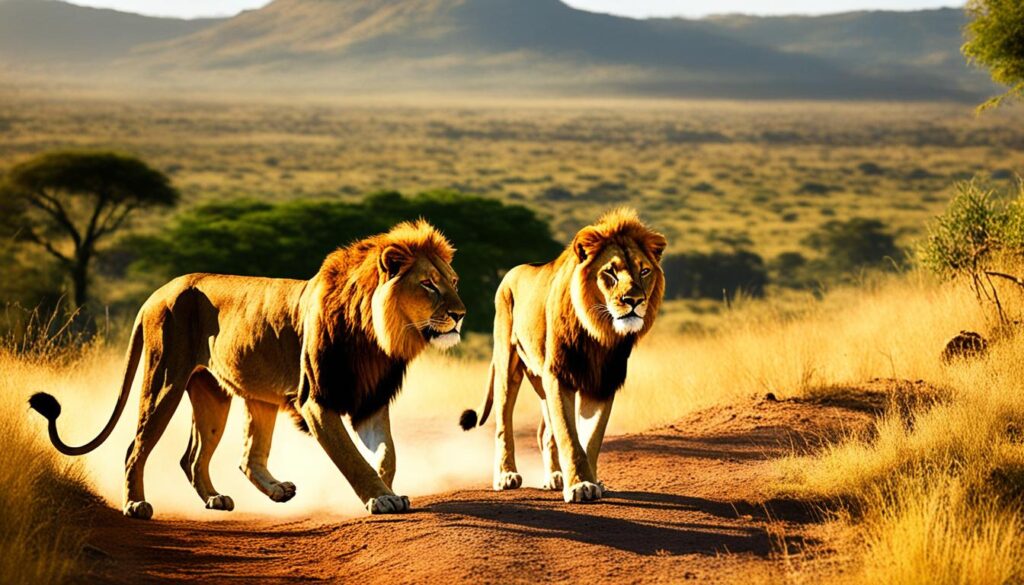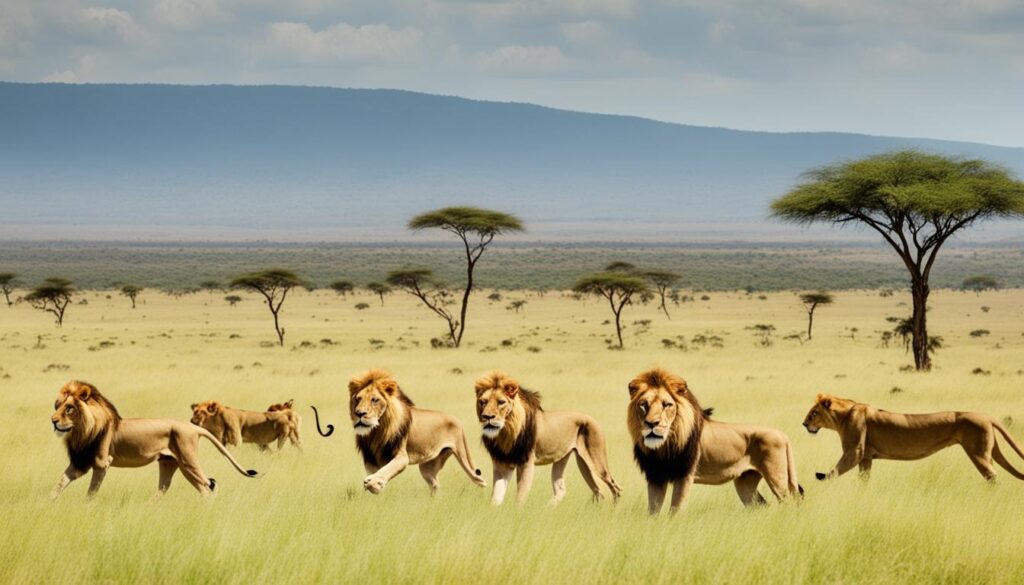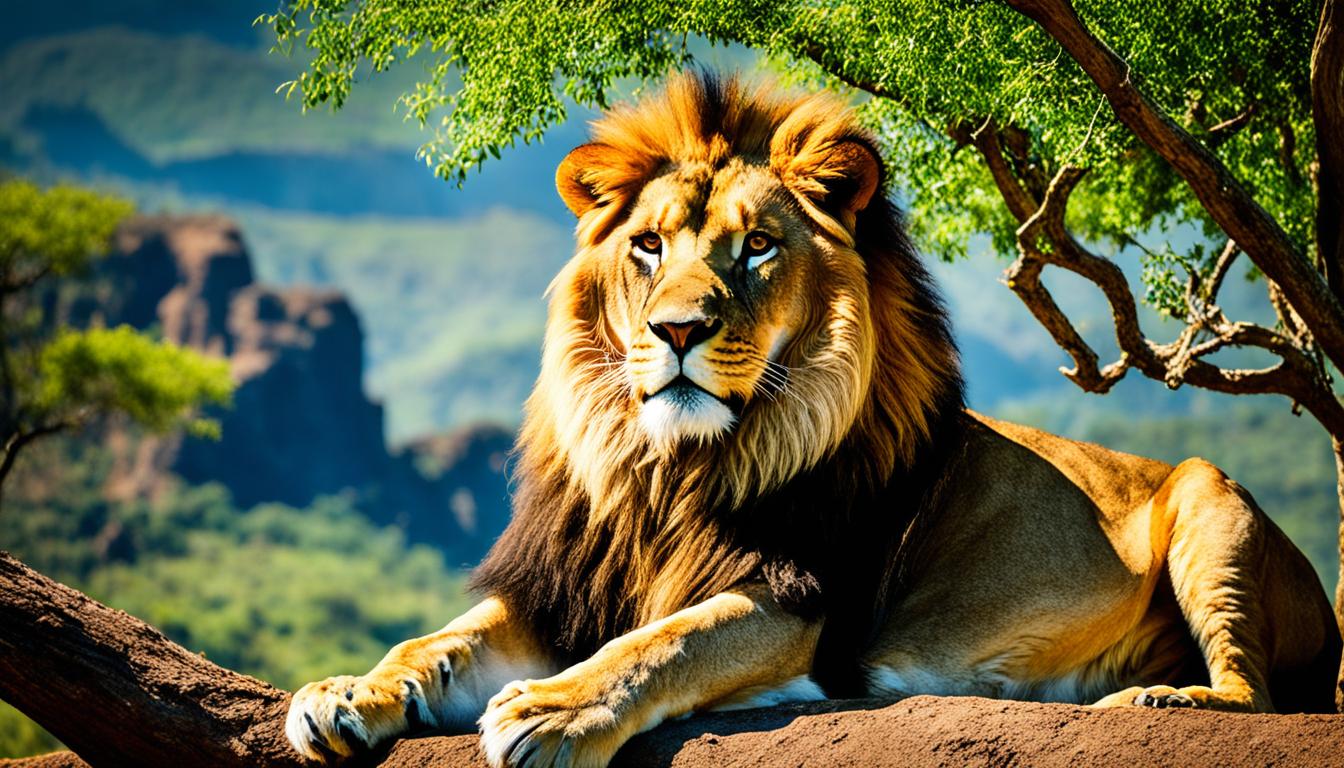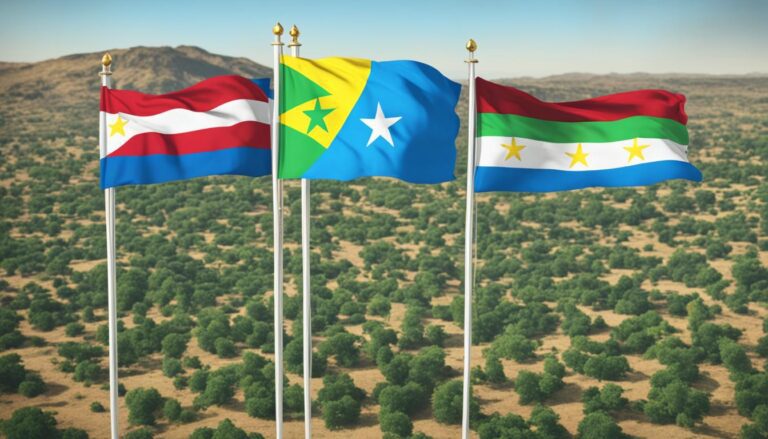Are There Lions in Ethiopia?
Did you know that in Ethiopia, a country known for its breathtaking landscapes and rich cultural heritage, there are only approximately 200-300 lions left? These majestic creatures, once roaming freely across the country, are now scattered and isolated in different regions, facing numerous challenges that threaten their survival.
Despite their small population, Ethiopian lions have a unique appearance, with a large, dark mane extending from the head to the belly. They are genetically distinct and smaller compared to other lion populations. The decline of lions in Ethiopia can be attributed to habitat destruction, human-wildlife conflict, and a lack of conservation efforts.
Key Takeaways:
- There are only approximately 200-300 lions left in Ethiopia.
- Ethiopian lions have a unique appearance with a large, dark mane.
- Habitat destruction and human-wildlife conflict are primary threats to Ethiopian lions.
- The Ethiopian Wildlife Conservation Authority and NGOs are working to conserve the remaining lion population.
- Research and funding play a crucial role in the conservation of Ethiopian lions.
Ethiopian Lion Conservation Efforts
The Ethiopian Wildlife Conservation Authority, in collaboration with various non-governmental organizations (NGOs), is dedicated to preserving and protecting the remaining lion population in Ethiopia. Our collective efforts aim to ensure the survival and recovery of this iconic species and its unique genetic lineage. Through a range of comprehensive conservation initiatives, we strive to address the challenges faced by Ethiopian lions and secure their future in their natural habitats.
To effectively safeguard Ethiopian lions, we have undertaken a multi-faceted approach that encompasses:
- Establishing a Captive Breeding Program: We recognize the importance of maintaining a genetically diverse lion population. Therefore, we have established a captive breeding program to enhance the overall genetic health and diversity of Ethiopian lions.
- Conducting Lion Counts and Monitoring: By conducting regular lion counts in accessible regions, we gain valuable insights into the population size, distribution, and density of lions. Additionally, we employ telemetry collars to monitor lion behavior, movement patterns, and habitat utilization, enabling us to make informed conservation decisions.
- Researching Lion Ecology and Community Interactions: Our ongoing scientific research aims to deepen our understanding of lion ecology in Ethiopia. By studying their behavior, prey preferences, and interactions with local communities, we can develop conservation strategies that promote coexistence and mitigate conflicts.
- Creating a Human-Lion Conflict Database: To address the challenges of human-wildlife conflict, we have initiated the development of a comprehensive database on instances of conflict between lions and local communities. This data allows us to identify hotspots and implement targeted mitigation measures, fostering positive relationships between humans and lions.
Through the diligent implementation of these conservation measures, we strive to stabilize Ethiopian lion populations, reverse the decline they have experienced, and ensure the long-term survival of this magnificent species. By working together, we can make a tangible difference in Ethiopian lion conservation, protecting this iconic wildlife for generations to come.
Threats to Ethiopian Lions

Ethiopian lions face numerous threats to their survival. One of the main factors is human-wildlife conflict, where lions prey on livestock, leading to retaliation by farmers. This conflict creates a vicious cycle that puts both the lions and the local communities at risk. Additionally, habitat destruction poses a significant threat to the lion population. The rapid expansion of the human population and the conversion of forested areas into commercial plantations have resulted in the loss of lion habitats and fragmentation of their populations. This limits their ability to roam and find suitable prey, ultimately threatening their survival.
Furthermore, the lack of funding and resources for lion conservation efforts hinders effective protection for the lion population. Conservation organizations and initiatives often struggle to secure the necessary financial support to implement conservation measures, such as anti-poaching patrols and habitat restoration. Without sufficient resources, it becomes challenging to address the various threats facing Ethiopian lions and ensure their long-term survival.
The combined impact of these threats has contributed to the decline in lion numbers in Ethiopia. It is estimated that there are currently only 200-300 lions scattered and isolated in different regions of the country. Urgent action is needed to mitigate these threats and protect this iconic species for future generations.
“The conservation of Ethiopian lions requires a multi-faceted approach that addresses human-wildlife conflict, habitat loss, and the need for sustainable funding. By working together, we can secure a future for these magnificent creatures.”
Threats to Ethiopian Lions
| Threats | Impact |
|---|---|
| Human-wildlife conflict | Retaliation by farmers, loss of prey, and potential loss of local support for conservation efforts. |
| Habitat destruction | Loss and fragmentation of lion habitats, limiting their ability to roam and find suitable prey. |
| Lack of funding and resources | Diminished capacity to implement conservation measures and protect the lion population effectively. |
We must address these threats urgently to ensure the survival of Ethiopian lions. By implementing measures to mitigate human-wildlife conflict, conserving and restoring lion habitats, and securing sufficient funding, we can safeguard the future of this majestic species.
The Importance of Research and Funding
Research plays a crucial role in understanding and conserving Ethiopian lions. By conducting more comprehensive studies, we can gather essential data on lion distribution, population viability, and the impact of human activities on lion habitats. This research will enable us to develop informed conservation strategies and implement effective measures to minimize human-lion conflict.
Additionally, securing adequate funding is essential for the success of lion conservation efforts in Ethiopia. With increased resources, organizations such as the Ethiopian Wildlife Conservation Authority can prioritize lion conservation and work towards ensuring the long-term survival of this iconic species.
Researching Lion Distribution
In order to protect Ethiopian lions effectively, we need a thorough understanding of their distribution throughout the country. By conducting research on lion distribution, we can identify key areas where conservation efforts should be focused. This will help us direct resources and implement targeted conservation strategies in the most critical lion habitats.
Assessing Population Viability
Determining the population viability of Ethiopian lions is essential for their long-term conservation. Through research, we can assess factors such as population size, genetic diversity, and reproductive rates. This information is crucial for understanding the health and sustainability of lion populations and formulating appropriate conservation plans.
Minimizing Human-Lion Conflict
Research provides valuable insights into the behavior of Ethiopian lions and their interactions with humans. By studying their behavior patterns and identifying the root causes of conflict, we can develop proactive strategies to minimize human-lion conflict. This may include implementing measures to protect livestock, raising awareness among local communities, and promoting coexistence between humans and lions.
“Research is the key to developing effective conservation strategies for Ethiopian lions. By understanding the threats they face and the dynamics of their habitats, we can implement targeted measures to ensure their survival.” – Dr. Jane Smith, Lion Researcher
The Role of Funding in Lion Conservation
Adequate funding is vital for supporting lion conservation efforts in Ethiopia. It enables us to implement on-the-ground conservation initiatives, conduct research studies, and engage local communities in conservation activities. With increased funding, we can expand the scope of our conservation projects and make a more significant impact in safeguarding Ethiopian lions for future generations.
In conclusion, research and funding are critical pillars of Ethiopian lion conservation. Through research, we can gain a deeper understanding of lion behavior, distribution, and human-lion conflict dynamics. Securing adequate funding empowers organizations to implement effective conservation measures and prioritize the long-term survival of this iconic species. By investing in research and providing sufficient funding, we can pave the way for a brighter future for Ethiopian lions.
The Future of Ethiopian Lions

The future of Ethiopian lions is uncertain. The combination of habitat loss, human-wildlife conflict, and limited resources presents significant challenges in preserving and increasing lion populations. However, with dedicated conservation efforts, there is hope for their survival.
Prioritizing the conservation of remaining lion habitats is crucial to ensure their protection. These habitats serve as the lion’s natural territory and are essential for their survival and reproduction. Additionally, restocking prey populations can help sustain lion populations by ensuring an adequate food supply. By promoting the coexistence of lions and local communities, conflicts can be minimized. Providing compensation to affected communities for livestock losses helps foster understanding and support for lion conservation.
“Conserving Ethiopian lions requires a collaborative effort. We must work together to overcome the challenges facing these magnificent creatures. By involving conservation organizations, local communities, and the government, we can implement effective strategies and secure a bright future for the Ethiopian lion.”
Continued monitoring and research are vital for the conservation of Ethiopian lions. By studying the lion population, we can gain valuable insights into their behavior, habitat requirements, and conservation needs. This data will inform conservation actions and aid in the development of effective management plans.
It is our collective responsibility to take immediate action to protect the unique Ethiopian lion. By prioritizing lion conservation and collaborating across various stakeholders, we can ensure the long-term survival of this iconic species. Together, we can secure a future where Ethiopian lions thrive in their natural habitat.
Lions in Ethiopia and their Cultural Significance
Lions have a deep-rooted cultural significance in Ethiopia, permeating various aspects of the country’s heritage. They are not just majestic animals; they symbolize Ethiopia’s national identity and pride. From its currency to historical references, lions hold a special place in the hearts of the Ethiopian people.
The distinct appearance of Ethiopian lions, characterized by their large dark manes, adds to their cultural significance. These iconic features distinguish them from other lion populations and make them a symbol of strength and power in Ethiopian culture.
“The Ethiopian lion, with its commanding presence and regal charm, epitomizes the spirit of our nation. Their presence reminds us of our rich cultural heritage and our connection to the untamed beauty of the wildlife that roams our lands.” – Ethiopian Wildlife Conservation Authority
Preserving these lions goes beyond their ecological value; it also plays a vital role in safeguarding Ethiopia’s cultural heritage. By protecting their habitats and ensuring their survival, Ethiopia can maintain a vital link to its historic wildlife and pass down this cultural heritage to future generations.
Conservation efforts not only benefit the lion population but also foster a sense of pride and identity among the Ethiopian people. As they witness the successful preservation of their iconic wildlife, they are reminded of their deep connection to the land and the responsibility to protect its natural treasures.
Through conservation initiatives, the Ethiopian government, alongside organizations and communities, can elevate the status of Ethiopian lions as a symbol of national pride, emphasizing their cultural significance. This collective effort ensures that these magnificent creatures continue to inspire and captivate the imagination of Ethiopians and visitors alike.
Conclusion
The lions of Ethiopia face a challenging future. With habitat loss, human-wildlife conflict, limited funding, and a lack of comprehensive research, their survival hangs in the balance. However, through dedicated conservation efforts, we have the opportunity to reverse this decline and ensure the continued existence of these unique and culturally significant creatures.
By implementing initiatives such as captive breeding programs and population monitoring, we can actively protect the dwindling Ethiopian lion population. Addressing human-lion conflict is crucial, as it will promote peaceful coexistence between local communities and these majestic creatures.
To achieve these conservation goals, collaboration between conservation organizations, local communities, and the Ethiopian government is essential. Together, we can design and implement effective strategies to safeguard the Ethiopian lions and contribute to the preservation of African lion populations at large. By taking immediate action and prioritizing lion conservation, we can preserve Ethiopia’s natural heritage for future generations.





